The Designer's Challenge: Four Problems You Must Solve

This talk was delivered as the commencement address to the School of Design, University of Pennsylvania, on May 14, 2007.
Dean Hack, distinguished faculty of the School of Design, honored guests, and most important, you the members of the class of 2007: It is a great privilege to stand before you on your graduation day.
As a Penn alumnus I feel a deep sense of affection for this institution and for this place. My own interest in design was kindled here long ago by Ian McHarg, who as much as anyone was the founder of modern landscape design and the larger field of ecological design. His book Design with Nature remains a classic statement of the art of intelligent inhabitation. From its founding, the city of Philadelphia has been home to a great deal of innovative urban design and experimentation now carried on here in the School of Design. You are a part of a great history and have inherited a legacy of which you may be justly proud. But the work of designers is now entering its critical and most important phase.
It is said that we are entitled to hold whatever opinions we choose, but we are not entitled to whatever facts we wish. Whatever opinions you may have, there are four facts that will fundamentally shape the world in which you will live and work.
The first is the fact that we spend upwards of 95 percent of our time in houses, cars, malls, and offices. We are becoming an indoor species increasingly shut off from sky, land, forests, waters, and animals. Nature, as a result, is becoming more and more an abstraction to us. The problem is most severe for children who now spend up to eight hours each day before a television or computer screen and less and less time outdoors in nature. Author Richard Louv describes the results as "nature deficit disorder" — the loss of our sense of rootedness in place and connection to the natural world. In some future time, it is not farfetched to think that disconnected and rootless we would become unhinged in a fundamental way and that is a spiritual crisis for which there is no precedent.
Second, when Benjamin Franklin walked the streets of Philadelphia there were fewer than one billion of us on Earth. The human population is now 6.5 billion and will likely crest at 9 or 10 billion. One-and-a-half billion live in the most abject poverty, while another billion live in considerable wealth. One billion suffer from the afflictions of eating too much while others suffer from malnutrition. When I was a graduate student at Penn the ratio of richest to poorest was said to be 35:1. It is now approaching 100:1 and growing. The problem of a more crowded world is not just about what ecologists call carrying capacity of the Earth. It also a problem of justice with more and more people competing for less and less.
A third fact has been particularly difficult for a society built on the foundation of cheap portable fossil fuels to acknowledge. We are at or near the year of peak oil extraction, the point at which we will have consumed the easy and better half of the accessible oil. The other half is harder to refine, farther out, and deeper down, and mostly located in places where people do not like us. We are not likely to run out of oil or liquid fossil fuels from one source or another, but we are nearing the end of the era of cheap oil. We have known this for decades, but we still have no coherent or farsighted energy policy. In the meantime the penalty for procrastination grows daily along with the risks of supply interruptions and volatile energy prices.
There is a fourth fact. When the University of Pennsylvania was founded the level of CO2 in the atmosphere was about 280 parts per million. But now the level of all human-generated heat-trapping gases is 430 parts per million CO2 equivalent. We have already warmed the Earth by .8 degrees C and are committed at least to another .6 degrees C. According to the scientists who participated in writing the Fourth Report for the Intergovernmental Panel on Climate Change we are not just warming the Earth, but destabilizing the entire planet. Climate scientist James Hansen says that we are close to making Earth a different planet and one that we will not much like.
Four facts.
One has to do with the largeness of the human spirit and our capacity to connect to life.
The second has to do with justice, fairness, and decency in a more crowded world.
The third has to do with our wisdom and creativity in the face of limits to the biosphere.
The last is about human survival on a hotter and less stable and predictable planet.
In the face of the remorseless working out of large numbers do you have reason to be optimistic? Frankly, no. Optimism is a prediction that the odds are in your favor — like being a Yankees fan with a one-run lead in the ninth inning and two outs and a two-strike count on a .200 hitter and Mariano Rivera — in his prime — on the mound. You have good reason to believe that you will win the game. That's optimism. The Red Sox fans, on the other hand, believing in the salvation of small percentages, hope for a hit to get the runner home from second base to tie the game. Optimism is a bet that the odds are in your favor; hope is the faith that things will work out whatever the odds. Hope is a verb with its sleeves rolled up. Hopeful people are actively engaged in defying the odds or changing the odds. But optimism leans back, puts its feet up, and sports a confident look knowing that the deck is stacked.
If you know enough, you cannot honestly be optimistic. But you have every reason to be hopeful and to act faithfully and competently on that hope. And what does that mean for you as designers?
My message to you is this. As designers you hold the keys to creating a far better world than that in prospect, but only if you respond creatively, smartly, wisely, and quickly to the four facts described above. Your generation does not have a choice to solve one or two of these problems. You must solve them all — rather like solving a quadratic equation. And you have no time to lose. As designers you must design so artfully and carefully as to help reconnect people to nature and to their places. You must design to promote justice in a more crowded world. You must design a world powered by efficiency and sunlight. You do not have the option of maintaining the status quo — a world dependent on ancient sunlight. And since Nature is a ruthless and unforgiving bookkeeper, you must do your work in a way that balances the carbon books. How will you do such things? The answers, fortunately, are many, but the principles of design are few. Let me suggest three.
The first has to do with the scope of your work. You must see design as a large and unifying concept — quite literally the remaking of the human presence on Earth. Design in its largest sense has to do with how we provision ourselves with food, energy, materials, shelter, livelihood, transport, water, and waste cycling. It is the calibration of human intentions with how the world works as a physical system and the awareness of how the world works to inform our intentions. And good design at all times joins our five senses (and perhaps others that we suspect) with the human fabricated world. When designers get it right, they create in ways that reinforce our common humanity at the deepest level.
Ecological design is flourishing in fields as diverse as architecture, landscape architecture, biomimicry, industrial ecology, urban planning, ecological engineering, agriculture, and forestry. It is gathering momentum, driven by necessity, better technology, and economic opportunity. Designers in diverse fields are learning how to
- use nature as the standard, as Ian McHarg proposed;
- power the world on current sunlight;
- eliminate waste;
- pay the full cost of development;
- build prosperity on a durable basis.
Design as a large concept means, in Wendell Berry felicitous words, "solving for pattern," creating solutions that solve many problems. When you solve for pattern you will also have created resilience, which is the capacity of systems to persist in a world perturbed by human error, malevolence, and what we call "acts of God." And by solving for pattern you are also likely to learn the virtues of reparability, redundancy, locality, and simplicity.
Here is an example of good design: Last week I took a class to a farm in Virginia in which the farmer raises poultry, cattle, and hogs so artfully that each element enhances the others while improving soil fertility and making a substantial profit by selling directly to a large base of local customers. As a designer, he has designed out chemicals, pollution, genetically modified organisms, pharmaceuticals, and most of the fossil fuels necessary to transport food long distances. The result is health in the large: of land, animals, people, and economy.
As a corollary, you must see yourselves as the designers, not just of buildings, landscapes, and objects, but of the systems in which these are components. That means that you must reckon with economic, political, and social aspects of design. And the hardest but most important object for designers is the design of what Peter Senge calls learning organizations, in which designing ecologically becomes the default setting, not an aberration.
Second, you will need a standard for your work, rather like the Hippocratic Oath or a compass by which you chart a journey. For that I propose that designers should aim to cause no ugliness, human or ecological, somewhere else or at some later time. That standard will cause you to think upstream from the particular design project or object to the wells, mines, forests, farms, and manufacturing establishments from which materials are drawn and crystallized into the particularities of design. It will cause you, as well, to look downstream to the effects of design on climate and health of people and ecosystems. If there is ugliness, human or ecological, at either end you cannot claim success as a designer regardless of the artfulness of what you make.
As a corollary, you, as designers, ought to think of yourselves first as place makers, not merely form makers. The difference is crucial. Form making puts a premium on artistry and sometimes merely fashion. It is mostly indifferent to human and ecological costs incurred elsewhere. The first rule of place making, on the other hand, is to honor and preserve other places, however remote in space and culture. When you become accomplished designers, of course, you will have mastered the integration of both making places and making them beautiful.
Third, as designers, you will need to place your work in a larger historical context — what philosopher Thomas Berry calls, your Great Work. No generation ever asks for its Great Work. The generation of the Civil War certainly did not wish to fight and die at places like Shiloh, Antietam, Gettysburg, or the Wilderness. But their Great Work, the end of human bondage, required just that of tens of thousands of them...and they rose to do their Great Work. Those now passing from the scene that Tom Brokaw calls "The Greatest Generation" did not wish to fight and die in places like Iwo Jima or the battlefields of Europe. But their Great Work, the fight against Nazism, required them to do so and they rose to the challenge to do their Great Work as well. Your Great Work, however, is not one of fighting wars, but of extending and speeding a worldwide ecological enlightenment that joins human needs and purposes with the way the world works as a biophysical system.
Your Great Work will be no less demanding and no less complex than that of any previous generation. But in outline it is very simple. Your Great Work as designers is to:
- Stabilize and reduce all heat trapping gases
- Make a rapid transition to efficiency and renewable energy
- Build a world secure by design for everyone...a world in which every child has a decent home, food, water, education, medical care
- Preserve the best of our history and culture
- Enable us to see our way forward to a world that is sustainable and spiritually sustaining
This challenge, your Great Work, is neither liberal nor conservative; neither Republican nor Democrat. It is, rather, the recognition that the present generation is a trustee standing midway between a distant past and the horizon of the future. As trustees we are obligated to pass on the best of our civilization and the ecological requisites on which it depends — including a stable climate and biological diversity — to future generations. The idea that we are no more than trustees was proposed long ago by Edmund Burke, the founder of modern conservatism (1790), and by one of the founders of modern revolutionary politics, Thomas Jefferson (1789), as well. It is a perspective that unites us across our present divisions in service to our posterity.
Your Great Work is a sacred trust given only to your generation. If you do not rise to do your Great Work, it will not be done. We know enough now to say what no other generation could rightfully say: the price for that dereliction — not rising to do your Great Work — will be high and perhaps total. Your Great Work as designers is to honor wholeness, health, and the great holy mystery of life. No other generation before you ever had a greater challenge and none more reason to rise to greatness.
My charge to you is to do your work so well that those who will look back on your time — the beneficiaries of your Great Work — will know that this was indeed humankind's finest hour.
Copyright© 2007 David W. Orr




